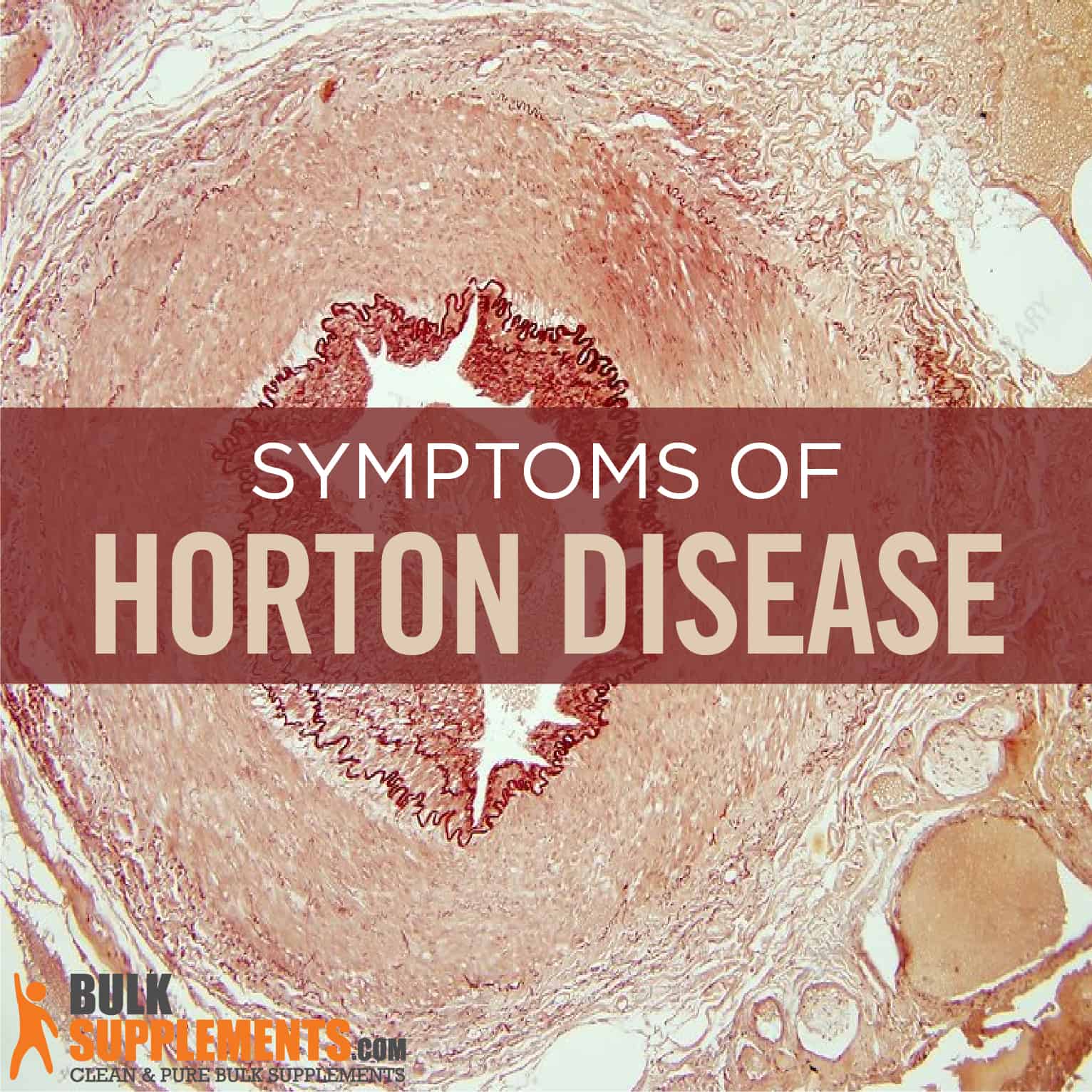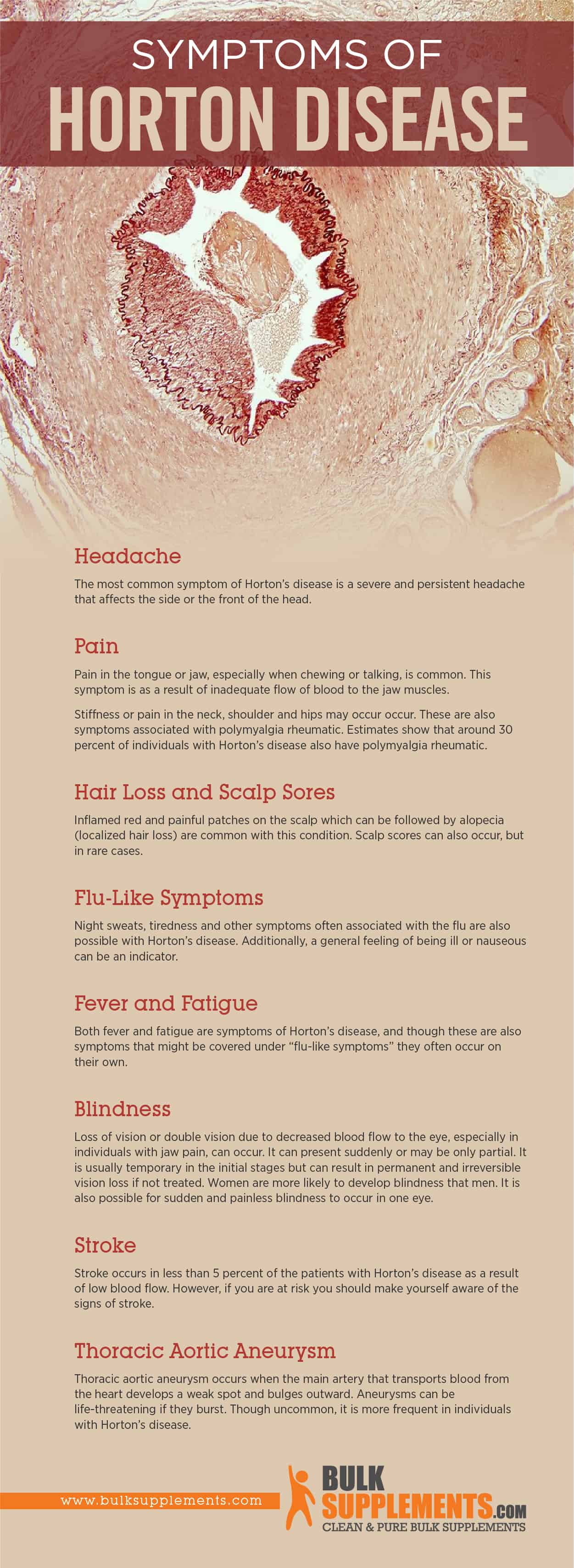Horton’s Disease: Symptoms, Causes & Treatment
by James Denlinger Digital Marketing Strategist
What is Horton’s Disease?
Horton’s disease, or ‘giant cell arteritis’ and ‘temporal arteritis,’ is an inflammation of the arteries, usually around the temples and eye area. Horton’s disease causes pain and swelling in the arteries of the head and neck. Inflammation causes a blockage and narrowing of the blood vessels, which interferes with blood flow. Horton’s disease is a form of vasculitis and can also be an autoimmune condition. This health condition usually affects individuals over the age of 50, especially women.
Horton’s disease causes damage to the blood vessels, making it difficult for blood to go to the brain. This can result in serious health problems like stroke and blindness if left untreated. People suffering from Horton’s disease often experience a painful, tender temple and scalp area. Other symptoms associated with Horton’s disease include fatigue, neck pain and double vision. Necrosis, tongue claudication and jaw claudication are some of the frequent oral symptoms.
The exact causes of Horton’s disease are unclear. There are no well-established risk factors or triggers. Horton’s disease is an autoimmune disease, meaning the body is attacked by its own immune system. In Horton’s disease, immune cells react against blood vessels, making their lining inflamed. Genetics and environmental factors may contribute to the development of Horton’s disease. Often, Horton’s disease can be linked to polymyalgia rheumatic (PMR), an inflammatory condition affecting the neck, hip girdle and shoulders. Smoking also increases the risk of developing Horton’s disease.
Prompt treatment can help relieve symptoms of Horton’s disease and might help prevent loss of vision. Patients start to feel better a few days after treatment. However, relapses might be common even after treatment.
Symptoms of Horton’s Disease
Headache
The most common symptom of Horton’s disease is a severe and persistent headache that affects the side or the front of the head.
Pain
Pain in the tongue or jaw, especially when chewing or talking, is common. This symptom is a result of inadequate flow of blood to the jaw muscles.
Stiffness or pain in the neck, shoulder and hips may occur. These are also symptoms associated with polymyalgia rheumatic. Estimates show that around 30 percent of individuals with Horton’s disease also have polymyalgia rheumatic.
Hair Loss and Scalp Sores
Inflamed red and painful patches on the scalp which can be followed by alopecia (localized hair loss) are common with this condition. Scalp sores can also occur, but in rare cases.
Flu-Like Symptoms
Night sweats, tiredness and other symptoms often associated with the flu are also possible with Horton’s disease. Additionally, a general feeling of being ill or nauseous can be an indicator.
Fever and Fatigue
Both fever and fatigue are symptoms of Horton’s disease, and though these are also symptoms that might be covered under “flu-like symptoms” they often occur on their own.
Blindness
Loss of vision or double vision due to decreased blood flow to the eye, especially in individuals with jaw pain, can occur. It can present suddenly, and may be only partial blindness or double version when it does occur. It is usually temporary in the initial stages but can result in permanent and irreversible vision loss if not treated. Women are more likely to develop blindness that men. It is also possible for sudden and painless blindness to occur in one eye.
Stroke
Stroke occurs in less than 5 percent of the patients with Horton’s disease as a result of low blood flow. However, if you are at risk you should make yourself aware of the signs of stroke.
Thoracic Aortic Aneurysm
Thoracic aortic aneurysm occurs when the main artery that transports blood from the heart develops a weak spot and bulges outward. Aneurysms can be life-threatening if they burst. Though uncommon, it is more frequent in individuals with Horton’s disease.

Causes of Horton’s Disease
The exact trigger or cause of Horton’s disease remains unclear. With Horton’s disease, the lining of the arteries become inflamed, making them swell. This swelling lowers the amount of blood delivered to the tissues of the body, and therefore they are starved of oxygen and important nutrients.
The condition can affect any artery of large or medium size, but the swelling is mainly in the arteries found in the temples. These are located in front of the ears and continue all the way into the scalp.
There are several factors which may increase the risk of developing Horton’s disease such as:
Age
Horton’s disease affects adults only. It rarely occurs in adults under 50. Most individuals with Horton’s disease start to show signs and symptoms between the ages of 70 and 80. The disease affects older adults almost exclusively.
Gender
Some believe that Horton’s disease only impacts men. According to the Danish Headache Centre, though, women often show the same characteristic symptoms as men and often go misdiagnosed. In fact, women are about twice more likely to develop Horton’s Disease than men.
Polymyalgia Rheumatica
Individuals with polymyalgia rheumatica are at a higher risk of developing Horton’s disease. These two conditions frequently affect the same demographics. An approximate 15 percent of individuals with polymyalgia rheumatica also have Horton’s disease.
Family History
Familial cases of Horton’s disease are possible. Researchers believe that individuals with Horton’s disease may have a genetic predisposition to the condition. A genetic predisposition means that an individual might carry a gene for a certain health condition, but it may not develop.
Diagnosing Horton’s Disease
Horton’s disease can be difficult to diagnose because its symptoms are similar to those of other health conditions. A health professional will try to rule out other possible causes of the problem. The doctor will ask about the symptoms and patient’s medical history. A physical exam that focuses on the temporal arteries may also be necessary. In most cases, one or both of these arteries are tender with a low pulse and a hard feel and appearance.
The following tests may be necessary:
Blood Tests
These are aimed at determining the level of inflammation. Tests that can help diagnose the condition are:
- C-reactive protein (CRP). This test is used to determine a substance produced by the liver if inflammation occurs in the body.
- Erythrocyte sedimentation rate. Also known as sed rate; this blood test helps to determine inflammation in the body by measuring the speed at which red blood cells settle at the bottom of a tube of blood.
Imaging Tests
These tests are used to diagnose Horton’s disease as well as monitor a patient’s response to treatment.
- Magnetic resonance imaging (MRI). This involves the use of a large magnet, radio waves and a computer to produce high quality pictures of inside the body.
- Magnetic resonance angiography (MRA). This test seeks to produce a detailed image of the blood vessels. It combines an MRI with the application of contrast material.
- Positron emission tomography (PET). This test may be necessary in cases where Horton’s disease has developed in large arteries, such as your aorta. It involves the use of an intravenous tracer solution with tiny amounts of radioactive material. This test can produce detailed images of the large blood vessels and also highlight areas of inflammation.
- Doppler ultrasound. This test produces images of the blood flowing through the blood vessels.
Biopsy
A biopsy of the artery wall is an option to assess for inflammation of the artery. In this test, a small piece of the artery is removed and examined under a microscope using local anesthesia. If a patient has Horton’s disease, the artery will show inflammation that includes giant cells (abnormally large cells). A biopsy can produce negative or normal results, even though the disease is present.
Treatment of Horton’s Disease
Treatment usually begins at once after confirmation of the results. It can also begin before confirmation so as to lower the risk of serious complications like vision loss.
Corticosteroid Drug
The main form of treatment is by use of a corticosteroid drug such as prednisone. Corticosteroids help to reduce inflammation in the arteries. Start using these drugs immediately.
The symptoms of Horton’s disease usually disappear with treatment. High corticosteroid doses should be maintained for 1 month to avoid any serious side effects like muscle weakness and high blood pressure. Over half the individuals who take corticosteroids for Horton’s disease will experience adverse effects. The dose normally ranges from 40 to 60 milligrams daily for the first month. During this period, a patient should notice a rapid improvement in their symptoms.
The treatments are said to have worked when the symptoms disappear and the sedimentation rate is at normal levels. Corticosteroid dose can be gradually reduced (x). The dose reduces such that a patient can take 5 to 10 milligrams daily for several months. As always, speak to your doctor to determine the best course of treatment for you.
Actemra
Adults with Horton’s disease can be treated with the biologic drug Actemra (tocilizumab). This drug is given as an injection and can also be used to treat rheumatoid arthritis. The drug impacts the immune system.
Actemra is associated with side effects like allergic reactions, stomach tears, alteration of blood composition and nervous system complications. People who experience headaches, upper respiratory tract infections and high blood pressure after taking the drug should see a doctor.
Aspirin
Aspirin can also be useful. However, it cannot be used if the patient has other underlying conditions like a bleeding disorder or stomach ulcers. If taken daily, low-dose aspirin can help lower the risk of stroke and blindness. Low-dose aspirin also helps reduce the risk of heart attack.
Supplements to Boost Your Immune System
As Horton’s disease is often linked to the immune system, it is advisable to support that system in any way possible. The supplements listed below are all linked to supporting immunity. Though before starting any supplemental regimen you should speak to your doctor, especially if there are other health conditions or medications present.
Beta Glucan
As a dietary supplement, take 250 mg of beta glucan powder once daily with a meal, or as directed by a physician. Use a digital gram scale for accurate measurements.
Echinacea Extract Powder
The ideal serving for echinacea extract powder is 450 mg (about ¼ tsp). Take it once daily. Follow a physician’s advice if they suggest an alternative dosage.
Curcumin
Take curcumin in one dose of 1,000 mg or less per day, depending on the intended effect. Take it with water or a meal. Roughly, 1,000 mg for this product is equal to less than ½ tsp, or a little more than 3/8 tsp.
Elderberry Extract Powder
As a dietary supplement, take 1,000 mg (1/2 tsp) to 3,000 (1 ½ tsp) of elderberry extract powder daily, or as directed by a physician.
Pure Shiitake Mushroom Extract Powder
As a dietary supplement, take 1,000 mg (scant ½ tsp) of shitake mushroom extract once or twice daily, or as directed by a physician.
Pure Astragalus Extract Powder
The ideal serving for astragalus extract powder is 1,300 mg. Take it daily with meals.
The Bottom Line
Horton’s disease is one of the most common vascular conditions. This health condition causes swelling, pain and the narrowing of medium-to-large arteries. The most affected arteries are the ones located on the head, neck, temples and upper body. Symptoms of Horton’s disease include stiffness in the shoulders and neck, fatigue, fever, headache, jaw pain and pain or tenderness of the scalp. The cause of this health condition remains a mystery, but immune function may be a factor. Adults aged over 50 and women are at the greatest risk. Support general body health and the immune system with lifestyle changes, a good diet and a variety of health supplements.
Sponsor Ads
Created on Mar 8th 2020 18:38. Viewed 327 times.




